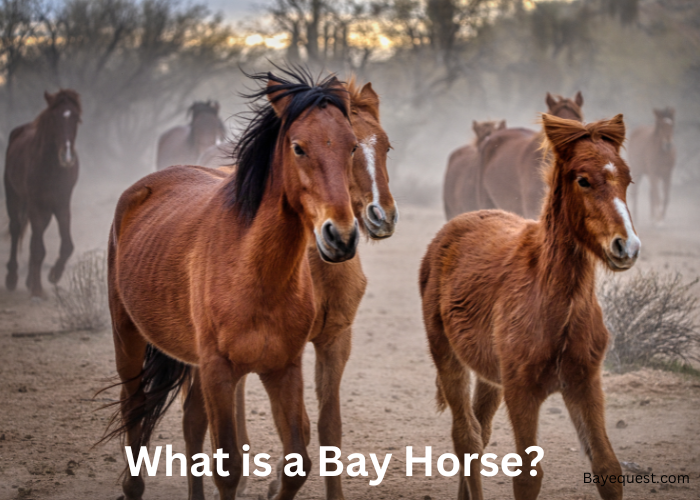There’s a horse that always turns heads. Its coat glows like autumn leaves, paired with a sleek, mysterious touch.
Known for their beauty and charm, these horses stand out wherever they go. You’ll spot them in fields, shows, or even timeless stories.
But what makes them so special? Is it their elegance, strength, or something more?
Let’s explore the captivating world of one of the most admired horses. Their story is one you won’t want to miss.
What is a Bay Horse?
A bay horse is a type of horse that has a reddish-brown or dark brown body, paired with a black mane, tail, and lower legs. This coat color is the result of specific genetic traits.
The bay color comes from a combination of the Agouti gene, which controls the distribution of black pigment on the horse’s body, and the Extension gene, which determines the base color.
The result is a beautiful contrast between the rich brown coat and the dark accents. Bay horses come in various shades, from a light, golden hue to a deep, dark brown.
This classic and attractive look makes them popular in many horse breeds.
Related read: What do You Call a Young Male Horse?
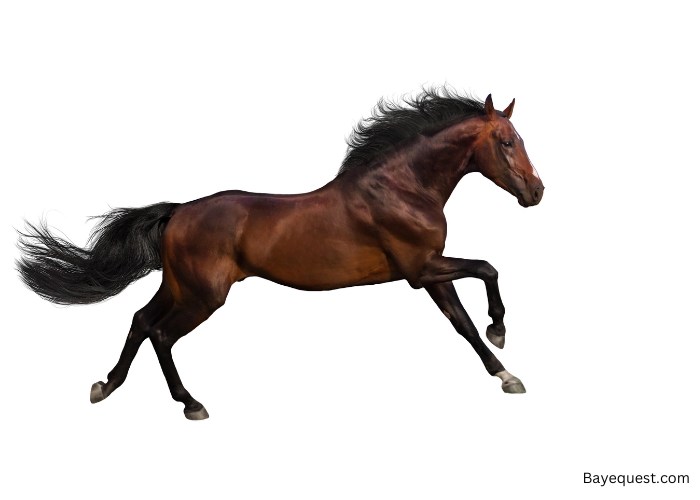
Defining Features of Bay Horses
Here’s what makes a bay horse stand out.
First, the coat color. Bay horses have a body that’s usually a rich brown or reddish-brown.
Some bay horses look almost golden in the sunlight, while others look darker, like deep mahogany.
Now, check out their mane, tail, and legs. These parts are always black, and the contrast with the brown body is a big giveaway.
Sometimes, you’ll see a bay horse with what we call black points—that’s the black on their ears and legs.
Bay horses can come in different shades. There’s the light bay, which has a bright, golden tone.
The standard bay is a solid brown, and the dark bay looks almost black but still has a brown body if you look closely.
In summary, a bay horse is about the beautiful blend of a brown body and striking black accents. This mix gives them their classic and eye-catching look.
Read also: What is a Grade Horse?
Genetic Makeup of a Bay Horse
First, there’s the Extension gene, which comes in two forms: E and e. The E form lets the horse produce black pigment, while the e form doesn’t. So, if a horse has at least one E, it can make black.
Next up is the Agouti gene, with its forms A and a. The A form tells the black pigment where it can go on the horse’s body, mostly restricting it to the mane, tail, and legs.
The a form doesn’t restrict black at all, so if a horse has an E and an a, it might be solid black.
For a horse to be bay, it needs to have at least one E and one A. The E makes sure there’s black pigment.
The A makes sure that black pigment gets pushed to the mane, tail, and legs, leaving the body a reddish-brown.
So, the genetic recipe for a bay horse is having both the E (for black pigment) and A (for controlling where that black goes) genes working together.
This combination results in a horse with a brown body and black points. It’s like painting a horse: the genes decide where the colors go.
| Gene | Variants | Function | Effect on coat color |
| Extension (E) | E | Produces black pigment | Allows black pigment to form (necessary for bay color) |
| e | Does not produce black pigment | No black pigment (results in red-based colors like chestnut) | |
| Agouti (A) | A | Controls distribution of black pigment | Restricts black to mane, tail, and legs (creates bay pattern) |
| a | Does not restrict black pigment | Black pigment covers entire body (leads to black coat if E is present) |
How the Genes Work Together
| Genotype | Outcome |
| E and A | Bay (black pigment in mane, tail, legs, with brown body) |
| E and a | Black (black pigment all over) |
| e and any combination of A or a | Red-based colors (like chestnut) since no black pigment is produced |
- Bay Horse: Has at least one E and one A (e.g., E/E or E/e with A/A or A/a).
- Black Horse: Has at least one E but no A (e.g., E/E or E/e with a/a).
- Chestnut Horse: Has no E (e.g., e/e, regardless of the Agouti gene).
For a horse to be bay:
- The extension gene must be E to produce black pigment.
- The Agouti gene must be A to restrict black pigment to the mane, tail, and legs.
Historical and Cultural Significance of Bay Horses
In history, bay horses have been the go-to for warriors and kings. Think of knights in shining armor riding into battle on sturdy bay steeds.
Their strong and eye-catching look made them favorites in royal stables and on the battlefield.
Because of their striking appearance, they were often seen as symbols of power and strength.
In literature and art, bay horses show up a lot. They’re the heroic mounts in countless stories and paintings.
Artists loved to capture their rich colors, and writers often chose them for the mounts of their heroes. Bay horses are mentioned in everything from ancient myths to classic novels.
In modern times, bay horses are stars in shows and competitions. Their striking color and natural elegance make them a hit in dressage, jumping, and even on the big screen.
They’re seen as versatile and reliable, a blend of beauty and brains.
So, bay horses aren’t just pretty faces. They carry a legacy of bravery, beauty, and nobility that spans centuries.
Whether galloping through history books or winning ribbons in the arena, bay horses hold a special place in our hearts and stories.
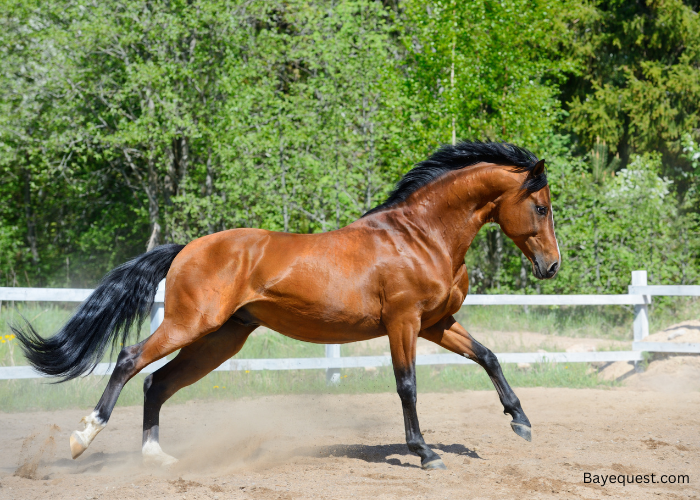
Shades of Bay Horses
Bay horses come in various shades, each with its unique charm. The different shades of bay make these horses special, from light and golden to deep and dark.
Here’s a rundown of the most common shades you’ll find.
Standard bay
The classic look. Standard bay horses have a deep, rich brown body with black mane, tail, and legs. This is the shade most people think of when they hear “bay horse.”
Sandy bay
Sandy bay horses have a lighter, more golden brown coat. They look like they’ve been dusted with sand, giving them a warm, sunny appearance.
The black points remain, but the body is lighter than the standard bay.
Blood bay
Think of a red wine color. Blood bay horses have a deep, reddish-brown coat that’s almost like the color of mahogany.
It’s more vibrant than the standard bay.
Amber champagne bay
These horses have a champagne twist. Amber champagne bay horses have a golden or amber coat with the usual black points.
Their color can be striking, with a metallic sheen that makes them stand out.
Silver bay
Silver bay horses are unique. They have a chocolate brown body with black points, but their mane and tail have a silver or grayish hue. This gives them a frosty, almost ethereal look.
Mahogany bay
Mahogany bay horses have a dark brown, almost black coat with a deep, reddish undertone. Their coats resemble polished mahogany wood, which gives them a rich, luxurious appearance.
Copper bay
These horses shine like a new penny. Copper bay horses have a bright, reddish-brown coat with a metallic gleam, which can look almost coppery. Their coats are eye-catching in any light.
Most Popular Bay Coat Colors
Bay horses come in a wide array of stunning colors, each with its unique beauty. Let’s delve into some of the most popular bay coat colors and what sets them apart.
Copper bay horses
Copper bay horses boast a bright, metallic, reddish-brown coat resembling the shine of a new penny.
This color is particularly striking because it seems to glow with a coppery brilliance, especially under sunlight.
Their black mane, tail, and legs contrast sharply, making their coppery coat stand out even more.
This shade is often sought after for its vibrant, eye-catching appearance.
Golden bay horses
Golden bay horses have a rich, warm, and golden brown coat, like liquid sunshine. Their body color can vary from a soft caramel to a deeper honey gold.
This shade has a beautiful, almost glowing quality, making these horses look bathed in perpetual sunlight.
The black points (mane, tail, and legs) add to their striking appearance, creating a beautiful contrast.
Blood bay horse colors
Blood bay horses have a deep, reddish-brown coat that resembles the rich color of mahogany or red wine.
This shade is darker and more intense than the standard bay, with a deep, almost crimson tint.
The rich red undertones of their coat give them a regal and powerful look.
Their black mane, tail, and legs accentuate the intensity of their body color, making them look elegant and robust.
Dark bay horse
Dark bay horses are almost black, with a very deep brown coat. At first glance, they might appear black, but a closer look reveals subtle brown or reddish highlights.
This shade gives them a sleek, sophisticated appearance. Their black mane, tail, and legs blend seamlessly with their body, enhancing their dark and mysterious allure.
This color is often favored for its classic, understated elegance.
Buckskin bay horses
Buckskin bay horses have a light, yellowish, or golden coat with the typical black points of a bay.
Their body color resembles buckskins, but the black mane, tail, and legs identify them as a bay type.
This combination gives them a striking and unique appearance. It blends the buckskin’s light, earthy tones with the classic bay markings.
Bay dun horses
Bay dun horses, also known as “zebra dun,” have a light brown or yellowish body with black points and primitive markings like a dorsal stripe and zebra-like stripes on their legs.
The dun gene lightens their base coat and adds these unique markings, giving them a rugged, wild look.
Their appearance is reminiscent of ancient horses and makes them look like they’ve stepped out of a prehistoric landscape.
Related read: Difference Between Dun and Buckskin Horses.
Wild bay horses
Wild bay horses have a light brown or reddish-brown body, but their black points don’t extend as far as in typical bays.
Instead, their black mane, tail, and lower legs are less pronounced, giving them a more subtle contrast.
This lighter distribution of black creates a softer, more natural look reminiscent of wild horses that have roamed freely.
Bay Pinto horse
Bay pinto horses have the classic bay coloration combined with large white patches. Their body can be a rich brown or reddish-brown with distinctive black points.
They also have striking white markings that can vary in size and shape.
This unique combination of bay and pinto patterns makes them stand out with a vibrant, eye-catching appearance.
Silver bay horses
Silver bay horses have a chocolate brown body with black points, but their mane and tail are silver or gray.
This gives them a striking, frosted look as if their dark coats were silver dust.
The silvering gene lightens their black hair, creating a beautiful contrast with their dark brown body, making them look almost ethereal.
Roan bay horses
Roan bay horses have a unique coat with brown and white hairs throughout their body.
Their base color is bay, with black points, but the white hairs give their coat a roaned, frosted appearance.
This blend creates a soft, almost speckled look, giving them a dynamic, textured appearance that changes with the seasons.
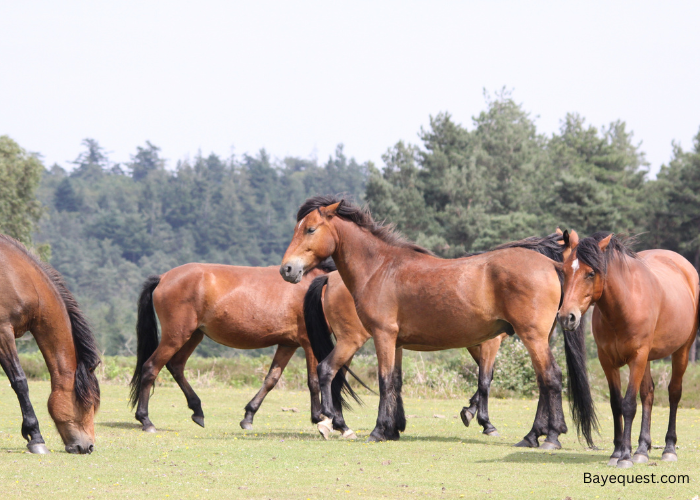
Breeds of Bay Horses
Bay is a popular coat color across many horse breeds, each showcasing this classic color uniquely. Here’s a look at the breeds where bay horses shine.
1. Thoroughbred
Thoroughbreds are frequently bay, with a rich brown coat and distinctive black points. This color complements their sleek, athletic build, making them stand out on the racetrack.
2. Quarter horse
Bay is a common color for Quarter Horses, appearing in various shades from light sandy to dark mahogany.
This color highlights their powerful and versatile nature, ideal for racing and ranch work.
3. Arabian
Arabian horses often feature the bay color, which enhances their refined and elegant appearance. The bay coat can range from bright, light bay to darker hues, emphasizing their graceful lines.
4. Morgan
Morgans frequently exhibit a bay coat, ranging from standard bay to darker variations. Their bay color adds to their traditional, versatile appeal, suitable for riding and driving.
5. American saddlebred
Bay is a popular color in American Saddlebreds, enhancing their smooth and flashy presence in the show ring.
The bay coat often has a glossy finish, making these horses a favorite in parades and performances.
6. Standardbred
Standardbreds commonly come in bay, from light to dark shades. Their bay color complements their solid, reliable appearance, especially in harness racing and driving.
7. Hanoverian
Hanoverians often sport a bay coat, which can range from a standard brown to darker shades. This color enhances their noble and strong look, making them a prominent choice in dressage and jumping.
8. Holsteiner
Bay is a frequent color in Holsteiners, highlighting their powerful and athletic build. The shades of bay add to their elegant and dynamic presence in jumping and eventing.
9. Trakehner
Trakehners are often seen in bay, which ranges from standard to darker tones.
Their bay color adds to their refined and athletic build, making them a preferred choice in various equestrian sports.
10. Cleveland bay
As their name suggests, Cleveland Bays are typically bay, with a solid brown coat and black points.
This uniform bay color is a breed hallmark, reflecting their strength and reliability.
11. Belgian warmblood
Bay is a common color for Belgian Warmbloods, appearing in shades from light to dark bay.
This color complements their athletic and elegant build, making them suitable for various equestrian disciplines.
12. Dutch warmblood
Dutch Warmbloods frequently come in bay, with a range of shades enhancing their versatile and athletic build. This color adds to their popularity in competitive equestrian sports.
13. Oldenburg
Bay is a prevalent color in Oldenburgs, from light sandy bay to dark, almost black bay.
Their bay coat enhances their strong, muscular appearance, making them favored in dressage and jumping.
14. Friesian sporthorse
Though traditionally black, Friesian Sporthorses, with a rich, dark brown coat, can also be bay.
This bay color adds a unique twist to their usually solid black appearance, reflecting their sporthorse versatility.
15. Appaloosa
Appaloosas can have a bay base color with their distinctive spotted patterns. The bay base, combined with the unique spotting, creates a striking, eye-catching appearance.
16. Andalusian
Bay Andalusians, though less common, showcase a rich, dark brown coat that adds to their powerful and majestic presence. The bay color can vary, highlighting their strong and elegant build.
17. Connemara pony
Bay Connemara ponies feature a range of bay shades, from light to dark. This color emphasizes their robust and versatile nature, making them popular for riding and driving.
18. Welsh pony and cob
Welsh Ponies and Cobs often come in bay, with various shades highlighting their compact and sturdy build.
The bay color adds to their traditional and versatile appeal, suitable for both riding and showing.
Read also: Brown Horses in the World.
Bay Duns and Other Variations
Bay horses come in fascinating variations that combine classic bay coloring with other unique patterns and genes.
Let’s explore some interesting types and see what makes each one special.
Bay dun
Bay duns have a bay base color with the addition of the dun gene. This gene lightens their body and adds distinctive markings like a dorsal stripe along the back and zebra-like stripes on the legs.
Their body color can vary from sandy brown to reddish-brown, but their black mane, tail, and legs remain.
This gives them a striking mix of bay color and primitive features.
Read also: Dunskin Horse Color.
Bay pinto
Bay pintos combine the bay color with the pinto pattern, meaning large white patches spread over their bodies.
These patches contrast their bay coat and classic black points, creating a vivid, piebald appearance.
This mix of bay and white makes them stand out in any setting, giving them a unique and eye-catching look.
Bay leopards
Bay leopards have a bay base coat with the leopard complex spotting pattern. They have a bay-colored body with white spots, often concentrated on the hips and flanks.
This pattern can create a beautiful, speckled effect, combining the bay color with an array of white spots. The result? A dramatic and striking appearance.
Bay roan
Bay roans blend the bay color with the roan gene, which causes white hairs to mix with the bay coat.
This gives them a frosted look, with a bay-colored head and legs while the rest of the body has a mix of white and bay hairs.
The contrast between the solid bay areas and the roaned parts makes them look both classic and unique.
Perlino horses
Perlino horses have a double cream gene on a bay base coat. This gene lightens their bay color to a creamy or pale gold, and their mane and tail often have a slightly darker, rusty hue.
Despite this lightened coat, they retain the bay points, though much lighter, giving them a soft and diluted appearance.
Buckskin horses
Buckskin horses have a single cream gene on a bay base coat, lighting the body color to a golden or yellowish hue while keeping the black points intact.
This gives them a beautiful golden body with a striking contrast from their black mane, tail, and legs.
They look like they’ve stepped out of a Western movie, combining elegance with a touch of wild.
Read also: Markings on Horse Face and Legs.
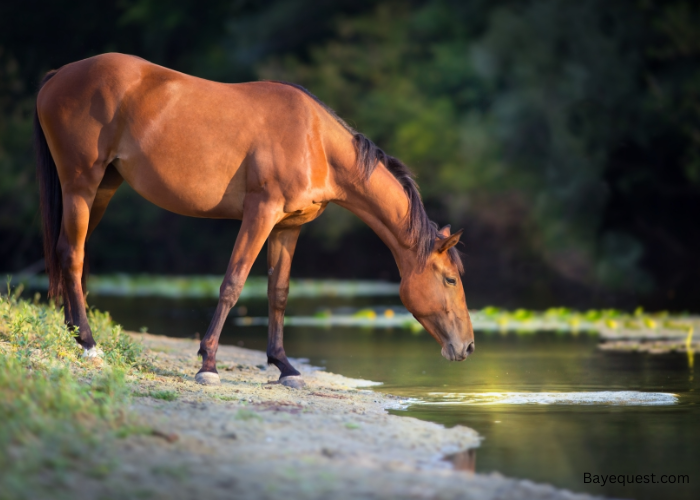
How Much Do Bay Horses Cost?
The cost of a bay horse varies widely, depending on factors like breed, training, age, and intended use.
Breed and bloodlines. Bay horses from prestigious breeds such as Thoroughbreds, Warmbloods, or Andalusians can cost $5,000 to over $100,000.
Common breeds like Quarter Horses or Arabians range from $3,000 to $25,000.
Training and experience. Training impacts a bay horse’s price.
Well-trained horses in disciplines like dressage or jumping can start around $10,000 and increase with their skills and achievements.
Young or minimally trained bay horses usually cost between $1,500 and $7,500, depending on their potential for future training.
Age and health. Younger, healthier bay horses with good prospects can range from $3,000 to $30,000.
Older horses or those with health issues might be more affordable, often between $1,000 and $10,000.
Purpose and usage. Horses intended for high-level competition or breeding are more expensive.
Based on their temperament and training, Bay horses for recreational riding or light work range from $2,000 to $15,000.
Fun Facts About Bay Horses
1. Bay horses are like the jeans of the horse world—they look good anywhere, whether on a racetrack, in a show ring, or just grazing in a field.
2. While bay is one of the most common horse colors, each bay horse can look quite different. Their shades range from light and sandy to dark and chocolatey.
3. Kings and knights often preferred bay horses for their bold and striking appearance. It was believed that their color symbolized strength and courage.
4. The bay color comes from a cool genetic mix. The Agouti gene controls where the black pigment goes, making the mane, tail, and legs black while the body stays brown.
5. Bay horses often look clean even when they’re a little dirty. Their dark points hide mud and dust pretty well, making them low-maintenance in the looks department.
6. Many bay horses are also talented jumpers. You’ll see them excelling in show jumping and eventing, where their elegant and powerful look shines.
7. Bay horses are popular in movies and TV shows. Their classic, photogenic color makes them perfect for the screen, often playing the hero’s trusty steed.
8. Not all bays look the same. They can be light like caramel or dark like mahogany, giving them a wide range of looks while still being bay.
9. Bay horses have existed for thousands of years. Archaeological finds show that ancient peoples prized them for their beauty and versatility.
10. Bay horses often catch the judge’s eye in competitions. Their bold color stands out against the backdrop of any arena, making them frequent winners in the show ring.
Interesting read: Unique Bay Horse Names.
Famous Bay Horses
Bay horses have graced the tracks, battled in wars, and starred in our stories with their distinctive brown coats and black points. Here are some legendary bay horses that have captured hearts and made history:
Secretariat. Known as one of the greatest racehorses of all time, Secretariat’s rich bay coat made him a striking figure as he thundered down the track to win the Triple Crown in 1973.
Man o’ War. This legendary racehorse dominated the early 20th century with his stunning speed and power. His dark bay coat made him an icon on and off the track.
Northern Dancer. A small but mighty bay Thoroughbred who won the Kentucky Derby and the Preakness Stakes in 1964. He became a leading sire, with his bay coat carried on by many of his descendants.
Seabiscuit. A bay Thoroughbred who became an American hero during the Great Depression. His rags-to-riches story and fighting spirit made him a legend, and his bay coat added to his everyman charm.
Bucephalus. The famous horse of Alexander the Great is known for his courage and strength in battle. This bay horse was considered as fierce as he was loyal, carrying Alexander through many conquests.
The Godolphin Arabian. One of the three foundation sires of the Thoroughbred breed, known for his bay coat. His legacy lives on through countless descendants, influencing the breed’s appearance and performance.
Ruffian. A dark bay filly who dominated the racetrack in the 1970s. Known for her incredible speed and tragic end, Ruffian remains a symbol of both brilliance and heartache in horse racing history. (Find out what filly horses are in our guide.)
American Pharoah. This bay wonder took the racing world by storm by winning the Triple Crown in 2015 and the Breeders’ Cup Classic, becoming the first horse to win the Grand Slam of Thoroughbred racing.
Affirmed. Known for his bright bay coat and his legendary rivalry with Alydar. Affirmed won the Triple Crown in 1978, cementing his place in racing history.
Frankel. A British bay Thoroughbred often called the best racehorse in the world. Undefeated in his career, Frankel dazzled fans with his speed and power on the track.
FAQs
What is the difference between a bay horse and a brown horse?
A bay horse has a reddish-brown body with a black mane, tail, and lower legs. Brown horses, on the other hand, are usually a more uniform, chocolate or seal brown color all over, without the distinct black points. So, if you see black on the mane, tail, and legs, you’re likely looking at a bay.
What is the difference between a red roan and a bay roan?
A red roan has a mix of white and red hairs over a chestnut base, giving it a reddish, frosted look. A bay roan has a mix of white and bay hairs over a bay base, with the classic black mane, tail, and legs of a bay horse. So, the main difference is the base color and the overall tint of their roan pattern.
Read also: Difference Between Sorrel and Chestnut.
Can a bay roan have a cream gene?
Yes, a bay roan can have a cream gene. If a bay roan has one cream gene, it’s called a buckskin roan, with a golden body, black points, and white roaning. If it has two cream genes, it’s called a perlino roan, with a pale cream body, light points, and white roaning. The cream gene lightens the base color while the roan gene adds the white hairs.
Is bay a dominant gene in horses?
Yes, the bay color is controlled by the dominant Agouti gene. This gene determines where the black pigment goes, restricting it to the mane, tail, and lower legs, resulting in the classic bay pattern. So, if a horse has the gene for bay color, it shows up unless another gene completely masks it.
Conclusion
So, there you have it—bay horses in all their glory. With their striking mix of brown and black, they’re the showstoppers of the horse world. They’ve got the charm, the history, and the looks that can’t be beat.
Whether they’re galloping in fields or winning races, bay horses leave a lasting impression. Next time you spot that beautiful blend of brown body and black mane, you’ll know exactly what you’re looking at.
Bay horses aren’t just a color; they’re a statement. And let’s be honest, they wear it well.




